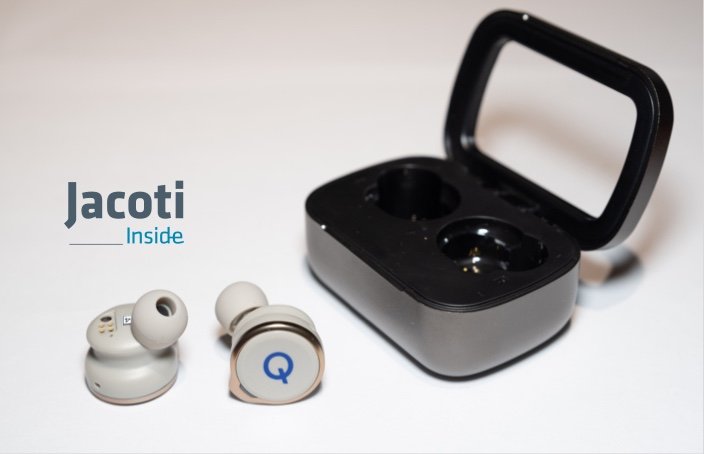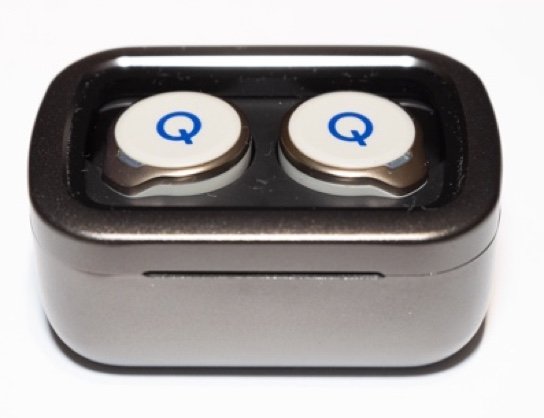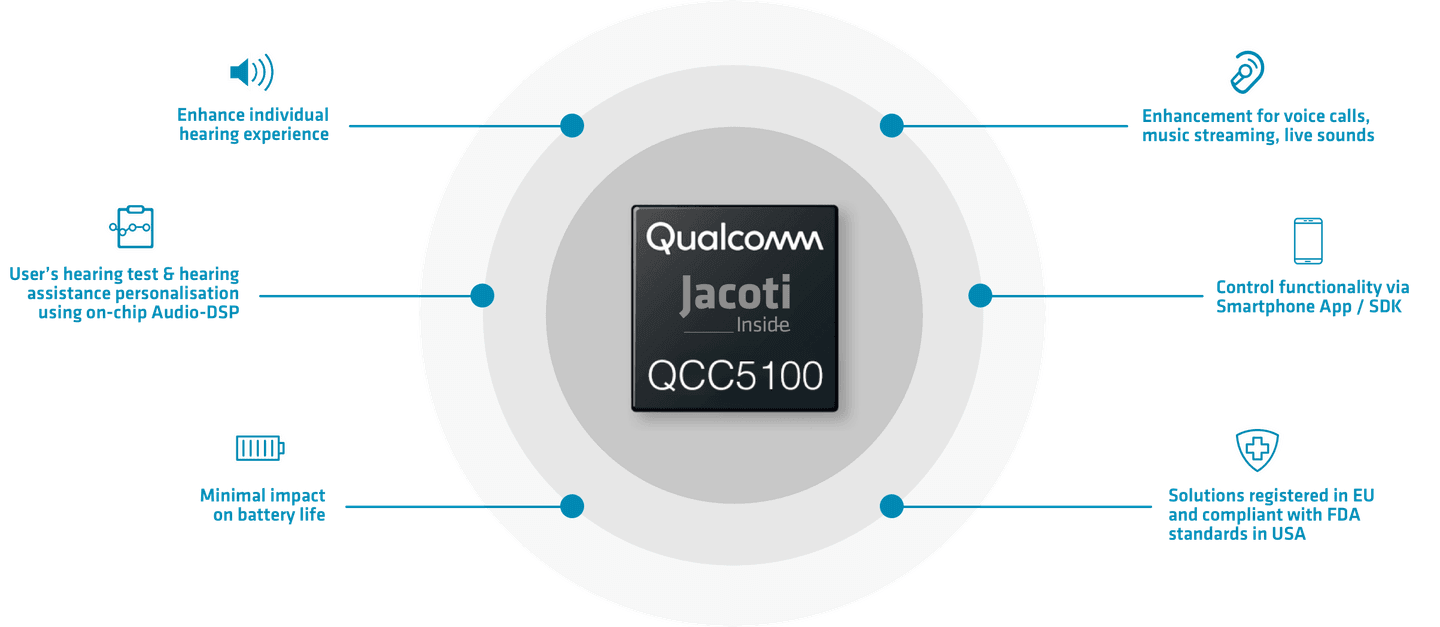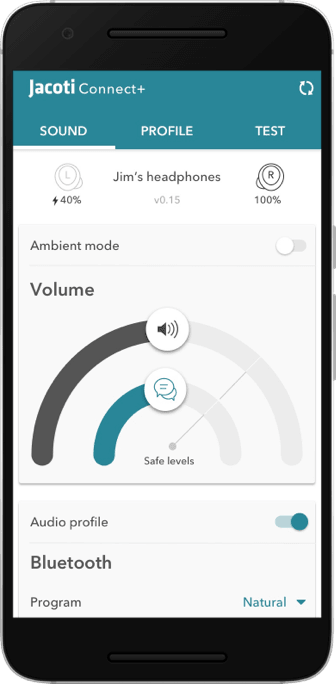My story and experiences with hearing tech in general and with Jacoti and its embedded hearing solutions in particular

About Jacoti
Jacoti BV | Hearing Technologies is a science-based company that develops hearing enhancement solutions embeddable in consumer devices. Its flagship product, Jacoti Inside, optimizes audio to each individual hearing requirement from consumer technologies to fully-fledged medical devices. For more information visit jacoti.com
Contact our Press Officer for more information or to arrange an interview with our team.
press@jacoti.comby Gerardo Murillo,
Audiology and Technical consultant on speech and hearing innovation
Hearing technology bridge me with others
I’m a “power” hearing aid user, suffering from hearing loss for a long time now. I cannot be without hearing aids. They bridge me with others. They allow me to connect to conferences, follow audio-video content on the internet, listen to music, to books, or carrying through presentations, courses, etc.
At the same time, I admit these devices do not fully satisfy me or solve all my hearing problems. This is probably not just due to a lack of professional support or own understanding.
My hearing care practitioner is a very experienced and competent person, knowing best practices and exploiting them for my and other patients' benefit.
Myself, I am acquainted enough with technology to make the best use of my devices. The wealth of my academic background and work experience is in electronics and speech signal processing.
Rediscovering sound richness with Jacoti’s technology
I believe that some shortcomings I experience with my hearing aids are partly because the fundamentals of hearing support have much been stationed on making sounds audible and as comfortable as possible when listening to one speaker, talking close to you, at a normal level, in a quiet place and assuming the only frequency range of interest is close to that of the old telephone system, basically the 300 to 3400 Hz band.
So, I’d better stick to hearing in these conditions (i.e. when I need the least of my hearing aids...) because whenever any of these "parameters" change, sound restitution quality decreases.
Poor sound quality is apparent when I listen to audio that is broader than this limited frequency range the hearing aids are meant for. Audio coming into my ears is also very poor (sounding very faint or unclear to me) in situations where the speaker is a bit far from me. And, naturally, it is also true for noisy environments. So "normal" hearing aid users have learned or accepted to live with this. Even coming to a point where you start thinking the “problem” is not with your hearing aids, but with your hearing, and that hearing aids can just help that much.
Experiencing Jacoti's technology has proven this assumption wrong. It has allowed me to rediscover many timbers I was not perceiving anymore and appreciating the richness and beauty of many sounds, in particular, music.
I listen to my preferred soundtracks by streaming audio directly into my hearing aids. Even if sound is still rather poor (with my hearing aids being designed only for compensating speech, although somehow adapted to music). When I do this using Jacoti's technology, compensated audio makes sounds so much brighter, richer and clearer, allowing me to notice (and re-appreciate) distinctly the different instruments, like the low frequencies of bass instruments like cellos or drums, or the high harmonics of a piccolo flute or triangles, for example. What a pleasure to hear a harp concert. And to pop music, where I can now clearly distinguish the spatial separation of instruments, with guitars in the left ear and keyboard on the right, for example.
People with hearing loss are also annoyed by loud sounds
Another limitation with my conventional hearing aids is this discomfort with “loud” levels, which happen normally, simply because there are high-intensity passages occurring during speech or music. These continuous high-energy nuclei transitions kind of “bump” into my eardrums (Yes, people with hearing loss are also annoyed by loud sounds). I was constantly moving volume up and down, never finding a pleasant position: either not loud enough, or uncomfortably loud. Naturally, my premium hearing aids come with multi-band compression, allowing for individual control of attack/release time constants and other compression/ expansion ratio parameters. These have been adjusted multiple times (too many?) by specialists, yet, this unpleasant sensation was still there: no "smooth" transitions.
When using Jacoti’s technology transitions are fluid and this discomfort just vanishes away. I can now relax while listening to speech or music content, without more need for continuous tweaking. This might be related to Jacoti’s proprietary algorithm for level detection and the rest of their automatic gain control scheme.
Jacoti's hearing compensation approach is medically certified and operates based on the same prescriptive fitting rules present in conventional hearing aids, however, it provides extended frequency sound quality enhancement, compared to the frequency band of conventional hearing aids if these devices. This brings remarkable enhancement on music, and also provides benefit in better speech perception, improved speech understanding in noisy environments, and enhanced sound source locating.
Jacoti “simple” hearing assessment methods
There is also a proprietary, self-administered hearing test using calibrated signals and monitoring ambient noise, in order to make test results valid. During this test, hearing thresholds are measured up to 12 K Hz and Jacoti’s fitting uses rules that actually determine compensation gain values up to those frequencies. This is a significant difference over conventional hearing aids.
Jacoti believes in preserving sound quality and avoiding too many "enhancements'', which introduce artifacts. So when you look at their fitting software, you miss many of those sophisticated setups you see at your audiologist. However this "simple" but scientific methodology proves to address and fix multiple issues I have with my 5000 euros pair.
Benefits perceived of Jacoti technology implemented into TWS earbuds

Jacoti technology is now implemented into TWS (true wireless stereo earbuds), meaning that all sound processing is done at the ear level, warranting an immediate response (no audio delay) and allows for independence on the smartphone model that plays the role of wireless control and command user interface. Moreover, the processor inside the earbuds (wireless audio system-on-chip) is not specifically designed, nor produced for hearing instruments. It comes from the consumer electronics market, meant for millions of customers and multiple applications and use cases. These semiconductor devices are available at unitary prices of around 5 euros. So even when adding the battery and the transducers, prices are factors of hundreds lower than conventional devices.
In fact, since quite some time now, we’ve seen initiatives looking at providing this solution to the many, centered on the smartphone. We know this device is ubiquitous around the world with people anywhere around the going around with their wired earbuds, listening to music or engaging in calls (We can agree that wireless earbuds are now taking over old wired ones and we must also concur that presently, stereo wireless earbuds are available everywhere and affordable for most anyone, with starting buyer’s price below the 10 €). Furthermore, we’ve all seen how computing power has increased in smartphones and how creating and installing apps has become simple and common.
All these are signs that smartphones can be in a natural way something close to hearing aids.
However, when providing a trustful solution for anyone, this has shortcomings: the diverseness of models and makes, implying different audio components, different processing capabilities, different operating system versions, different sound quality in sum. So different smartphones would render hearing enhancements more or less effectively.
Audio delays variability
Wireless earbuds also suffer from the “audio delay” which has a high impact on live audio. This comes from the Wireless radio transmission time between the smartphone and earbuds themselves. This delay is very variable between smartphone models.
An alternative path is implementing this technology on Apple phones, which models come with a full uniform quality worldwide (components, production, operating system, etc.). Also, from the smartphone start, Apple has used a performant audio architecture: Low delays, high quality, good electroacoustic specs, etc.
Jacoti has provided its technology gratuitously to any iPhone or iPad user for the last ten years or so. This has confirmed Jacoti’s technical superiority with an audience in the thousands, nevertheless tied to Apple’s strategy and available only for those capable of meeting the expense of such devices.
My experience with Jacoti Inside
Today, Jacoti provides its technology to major consumer audio product manufacturers as software for them to embed into their programmable devices (Jacoti Inside). By this means, consumers benefit automatically from these audio enhancements, without changing anything else inside their devices.

Moreover, this methodology is designed in such a way that it is personalized and directly usable by practically most people. Indeed, it comes with a Hearing Test, allowing to determine where and how much hearing compensation each person needs. This self-administered test can be taken in a simple non-noisy environment, without the need for a sound-isolating booth, nor any other clinical setting, nor does it require a hearing aid specialist to be present. At the same time, audiograms with Jacoti’s Hearing Test have been controlled and compared to those of a clinical setup with professional equipment: They yield measures that are as precise. As a matter of fact, this Jacoti hearing test with a consumer market device is the only one currently medically certified in Europe and America (CE and FDA stamped).
Furthermore, the smartphone which is used to control this test (which operates fully from the DSPs in the earphones) connects via the internet to Jacoti earCloud®. Upon user agreement, any hearing aid professional can access this database and monitor the hearing loss and adjust fittings, if ever necessary. This hearing test method is the same as clinical audiology, so audiograms data obtained in a clinical environment can be used equally for the fittings and vice-versa.

Clearly, Jacoti smartphone app JacotiConnect, is a nice user interface that makes it easy and pleasant to control multiple hearing loss compensation features, from volume, through equalizing, to selected preprogrammed profiles adapted for different audio content and many other things.
Naturally, once the earbuds are personalized for your own needs and likings, this configuration stays active on the earbuds without the need to still run this application.
JacotiConnect enables controlling not only the streamed audio coming via Bluetooth, but also the “Ambient” audio coming via the earbud’s mics. Both of them support Jacoti’s hearing compensation schemes and either of them can be enabled separately, or ran in parallel. Mixed mode allows you to be aware of sounds in your surroundings while listening to streamed content. And volume for streamed audio is handled separately from Gain for Ambient sound, which permits personalizing this mix. Again, all these settings remain enabled even when you close JacotiConnect. When you want to modify them, then just open the app again.
There are multiple other great functionalities in Jacoti’s embedded technology which I appreciate. In a nutshell, this “Jacoti’s inside TWS” undoubtedly magnifies my listening experience. It is honestly excellent and I hope this testimony of mine persuades many people to appraise it also. It is truly worth the try!